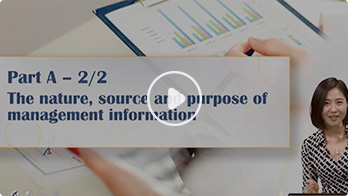
ACCA考试科目P2 March2018考点预测和答题技巧,49 or 50?ACCA题库,戳:ACCA题库【手机可刷+全球题库】(按照知识点进行分类配题,有知识点没有搞懂,无法解锁,直至掌握,目前阶段免费)
目录:
1.BubbleBai’s 3C model
2.击破P2的最佳武器
3.Q1
4.Q2 Q3
5.Q4
附:Q2Q3改写答案
1.BubbleBai’s 3C model
也就是Pass P2的三个key words,我会把这个model贯穿全文。
2.击破P2的最佳武器(帮你拿到49分与50分的关键一分)
一定尽量写doubleentry:
从F3开始,大家就开始接触double entry,但是不要觉得它“简单”而轻视它。其实它是P2的“基础”,是解决P2所有复杂题目的golden key。
比如很多同学complain,Q1计算和Q2Q3的准则分析,不但题目复杂,甚至看不懂考官答案。原因就是,考官故意没写double entry(他默认你懂DR CR)。每一个accounting transaction都可以写DR CR,而一旦写下来,交易实质就非常清楚了。
如果你能写DR CR,marker会认为你会计基础功扎实,不是“速成”的学生,你就能拿到49分与50分的关键一分。把最简单的招式,发挥到极致,就是你的绝招。
如果你整张卷子,一个double entry都没有,那就非常危险了。
请参考附录中我改写的真题答案。
“对我们会计而言,Doubleentry is the most powerful weapon,好似舞者的舞鞋,剑客的佩剑,就是死,也是不能放下的。Learn it,use it,and love it.
------Bubble Bai”
3.Section A Q1 50 marks
a)35 marks合并报表,是重点拿分项(尤其是没有工作经验的同学)!!!。35分纯计算,所以一定要高度熟练,合并的基本步骤要烂熟于胸。
预测:最近两次考试,17Dec IS;17Sep Cash flow。对于March 18,我预测概率是:FP 60%;Cash flow 30%;IS10%.(也就是说,如果你到今天才开始练题,IS可以放弃了)。不过考官曾经连续5次考FP,强烈释放一个信号:不要猜题!!考官还是用心良苦,希望我们学到知识。
三种类型
Complex group
Change in group structure(increaseshares/decrease shares)
Foreign subsidiary
首先,你可以排除掉foreignsubsidiary,因为Dec17才考了。
关于complex group,计算要点是GW from S.S。我们的思路是P直接收购S.S,所以purchase consideration in S.S.只能考虑P的出资部分,所以题目给的Subsidiary’sinvestment in S.S一定要*P’s%in S。(BTW,很久没考complex group了)
关于change in groupstructure,是考官最近两年的热点(因为in real business world,风云变幻,现在最时髦的就是股权变更。实务中的热点,就是考点)无论增持还是减持,请大家需要特别注意的是:是否从非S变成S?是否从S变成非S?前者需要计算GW,后者则失去GW同时产生gain/loss.这两种情况,合并报表会有非常显著的变化,一定是考官的重点。另外,无论增持还是减持,只要Sub is still Sub,no gain no loss,don’ttouch GW!!
经典题目:
Kutchen(CSFP,decrease)
Trailer(CSFP,complex)
Joey(CSFP,increase)
Bubble(CSFP,foreign sub)
Zippy(IS)
Jocatt(Cash flow)
针对March 2018,前三题必练!
Tips for Q1 a)
Note 1-4:consolidation;Note 5-7:single standard
Pure computation,no discussion necessary
Double entry will be helpful
Don’t panic=>no perfect answer
GW is a MUST!!(无论考FP or IS or Cashflow)
Time management=>save sufficient time for Q23
Use format to calculate GW,NCI
Consolidation是有固定格式和working的,能帮你拿到easy marks。请你一定按照老师整理的格式,按部就班;self-study同学可以参考Kaplan/Bpp.最糟糕的就是看考官答案(怎一个“乱”字了得)。
b)8 marks:可能有部分计算,也可能是全文字题;难易程度不确定。
三种类型
讲情怀讲故事讲历史知识面必须广(不局限于P2“常规”考点)
比如Marchant b)考的就是FV model和cost model的相爱相杀,死死纠缠;在新时代面前,怎么应对外界对我们财务工作的质疑,怎么提高财务报表的质量?
又比如Zippy b)考的是你从F3就接触的OCI。OCI和PAT到底有神马区别?现有准则的规定难道不是自相矛盾吗?有瑕疵吗?你有修改建议吗?
考F7知识点
比如Past paper-June17-substance over form,factoring receivables。如果把这道题放在F7考,大家都能做对,可惜放在P2,我们只能一声叹息:忘了。
基于常见考点,再深入探讨新/非热门考点
比如Past paper-Joey b)考的是Groupshare-based payment。教材里面可能只有两句话,老师上课的时候可能就pass过去了,因为根本不是重点和常见考点。考生遇到这类题目,千万不要怕,其实基于你对share-based payment的基础知识,是可以现场推导出来结论的。考官就是要考察你随机应变,能否具备处理新事宜的能力。
Tips for Q1 b)
这题,会比较NEW,做好心理准备。
这题,很有可能open-endedquestion,没有正确答案,只要你自圆其说。
这题,可能会计前沿问题,学术界有争议/争论,最好可以出几个对立观点。
基于前面三点,这题,只要你做,就有分,所以一定要给足时间认真做。
谈到这里,引出Bubble Bai’s 3C model,第一个Confidence。不要怕新题,你可以的!
c)7 marks:ethics,CG,or CSR.无需特别准备,都是F8和P1的套话。最重要的是,timemanagement,一定要拿到这个easymarks,只要你随便写写,就能拿分!!
Types
Accounting related ethics:首先state相关准则,正确处理,然后调错帐。最后才说ethics
Non-accounting related ethics:Integratedreporting,stainable development,environmental issue,insider dealing,etc.
常用单词和模型如下:
•Conceptual framework:obj.of FS(Toprovide useful information to users);qualitative characteristics
•Tucker’s 5 Question Model(profitable?Legal?Fair?Right?Sustainable?)
•ACCA code’s of ethics:integrity,objectivity,professional competence,confidentiality,professional behavior
•Ethical behavior threats:self-interest,self-review,advocacy,familiarity,intimidation.
4.Section B Q2 Q3
BubbleBai’s 3C model:communication
你的答卷,就是你和maker之间的communication.How to enhance communication?其中之一,就是格式。比如consolidation的W1-W5,规定格式;比如Q23的上述格式。节约marker阅卷时间,同时你自己的思路也更清晰。
权重:如果这道题10分,Step 1-1mark;Step 2-3 marks;Step 3-4marks;Step 4-2marks.所以,第一:一定要背准则,第二:一定要apply准则到case,仔细读题,identify key words in the case和准则的points一一对应(就是抄题,不过要适当缩写,简写);第三:结论:CFO是对是错?错了,应该怎么办?最好能写DR CR,少说废话,一针见血。如果你的结论和考官答案不一致,没关系,只要你言之有理(marker看重的是你的推理过程),一样拿分。何况P2的transaction太复杂,就是官方答案争议也比较大,不用纠结。
一般来说,Q2 is focus:Focus on 1 or 2 standards。Q3 is mixed:more standards will be tested.所以Q2考得要深入一些,难一些。
Q2Q3的难题,可以归纳为4类,请各位对号入座:
“似是而非”型。
比如Margie这道题,题目说这个transaction是IFRS2 share-based payment,其实是考官故意误导你。仔细读题,发现其实a)B)c)都不是IFRS2.所以找对准则很重要,因为这是Step1。
应对策略:无他,熟悉准则,背准则
“自相矛盾”型
比如Aspire a)这道题,问:Aspire公司的functional currency是神马?仔细读题,会发现有一些indicators指向Dollar,又有一些indicators指向Dinar。
应对策略:答题时,你不要害怕你找到的indicators自相矛盾,反而应该一一列下来,一一分析,这些分析才是拿分点。
“不知所云”型
比如Coatin B),题目很长,很吓人,很高大上,读不懂,完全不知所云。
应对策略:题目越长,越复杂,越容易拿分,因为涉及准则越多!(这道题涉及IAS 37,IFRS 9,IAS 10,IAS 24,IFRS 13)找到准则,谈谈definition,就有分啦!当然,如果你功底扎实,能写DRCR就更好了!
请同时参考Evlove(Dec16)C),涉及IFRS 3,IAS 40,IAS 12,IAS 16
“个人魅力”型
P2考官不是闭门造车,每一道题都有真实原型,比如Coatin a).这道题说的是在金融危机中,政府收购了一家bank。
应对策略:如果你能够写出一句话“这道题的真实原型是2008年美国金融危机,美国政府为了救市,大幅增持银行股,成为了很多银行的biggest shareholder,比如citi bank花旗银行”,只需要这一句话,marker就认为是这是整个卷子的亮点,(your show time!)这也是49分-50分那一分。如果恰好是examiner阅你的卷(考官每次都会亲自阅卷,至少500份,来保持和考生的密切联系),那他不但让你pass,并且让你高分pass,因为你!懂!他!
如果要抓住这种机会,必须平时有积累,因为工作的原因,我至少看过上千家公司的financial statements!英国的“獐子岛”,巴菲特吐槽会计准则,Paris Agreement,已经或者以后会出现在ACCA考卷中,就看你能否抓住机会。只有你打开眼界,关心世界,才能更好的考试。
引入Bubble Bai’s 3Cmodel-last key word:Common sense
就P2而言,最基本的Common sense
Why?CFO为何要做假账?他的Intention?
Stakeholders什么反应?最重要的Shareholders会怎么看?
Debt or equity?CFO更喜欢equity
准则本身有没有瑕疵?
实务中的热门:经济放缓,impairment–GW/PPE;non-GAAP,presentation;科技公司/internet company,可否capitalize IA?
Tips for Q23
找对准则
找全准则
Use common sense
Hot topic for March 2018:revenue,lease,deferred tax,IFRS 2,pension,IFRS 9,provision,IA
5.Section B Q4
current issue,这个要看ED和DP还有考官文章,也需要较高的essay写作能力,一般来说不建议选做,节约复习的范围。(如果你不选Q4,可以不用看考官文章,节约时间).我的预测March 2018 Q4
考官文章:“MEASUREMENT”-发表于2017.11我写了summary,请参考文末附录。
考官文章:“IAS 21-DOES IT NEED AMENDING?”-发表于2017.11。我写了summary,请参考文末附录。
ED-materiality.什么是重要性?这个很大程度依赖于professionaljudgment;对userdecision making有用的信息,就重要,反之不重要;根据transaction’snature/frequency/amount判断是否重要;根据individual or collective basis,做出assessment;toomuch immaterial information may obscure material information,应该避免too much excessiveinformation
6.Review Bubble Bai’s 3C model
Confidence
Common sense
Communication
7.Bonus
既然你都看到这里了,附上一个bonus point.我在参加ACCA官方培训(考官和marker)的时候,考官吐槽了很多marginal failing的常见问题,“没有自己的分析,只会copy textbook,page of pages of pages”;“对P2没有敬畏之心,以为全部的题目都是考过的,遇到新的就崩溃”。
(不想考49分的童鞋注意啦)
8.附上Greenie,2010December Q3 a)答案(注意要有小标题,要分段哦)
Q3 Greenie
a)Airportaccident
Provision and contingent liability(要有小标题)
IAS 37defines“Contingent liability”as……..(定义背准则)
“Provision”is….(定义背准则)
Conditions mustbe met to recognize a provision.
In the case ofGreenie,(引用原文的key words)…..“in progress”“no conclusion”“expertreport is expected in 2011,now 2010”“nature and extent of the damage notestablished”……
Thus(结论),contingentliability is correct conclusion.Directors of Greenie is right.
Contingentasset(小标题)
Insurance:thepossible recovery of the cost from insurance company is contingent asset.
Margie 2010 December Q2 d)答案
d)
IFRS 2
The grant ofoptions to employees clearly falls within the scope of IFRS 2.
In this case,theperformance condition must be met beforeshares vesting.And it also covers servicecondition that employee has remained in this company.
The estimatedvesting period was 4 years.Thus,the total expense should be allocated tothose 4 years.There is no need for double entries at the grant date.
At the end ofyear 1,Nov 30,2008
Dr expense100*4000*$10/4 years=$1
Cr equity$1
At the end ofyear 2,Nov 30,2009
DR expense$1
CR equity$1
At the end ofyear 3,(30 November 2010),The estimation changed.Since share price hasincreased to$15,performance condition met.(I assume employees are still inthe company).All total expense for this share option$4 should be allaccounted for at the end of year 3.The leftover$2 should be accountedimmediately.
DR expense$4-$2=2
CR equity$2
考官文章IAS 21-DOES IT NEED AMENDING?
Bai’s comment:
这可能是最搞笑的一篇考官文章。因为题目是:does IAS 21 needamending?阐述了5页之后,结论是:不需要修改。
所以这篇文章再次深刻体现了西方的逻辑思维方式:结果如何不重要,关键是讨论/论证的过程
background:IAS 21是1982 issued,比较老,而且里面有一些有争议的部分。
Summary
1)Foreign exchange market is affected by many factors,this market suffer from Volatility.
2)IFRS 7和IAS 21有相关内容,但是两者conceptual basisare different.IFRS 7 is based upon the distinction betweenfinancial/non-financial elements,whereas IAS 21 utilizes themonetary/non-monetary distinction.所以两者caused potentialconceptual confusion.
3)根据IAS21,Exchangedifferences arising from monetary items are reported in profit or loss in theperiod,with one exception which is that exchange differences arising onmonetary items that form part of the reporting entity’s net investment in aforeign operation are recognised initially in other comprehensive income,andin profit or loss on disposal of the net investment.就是说foreign S帐上的cash等monetary assets,产生的diff是计入OCI的。很多人质疑,因为monetary assetsdiff should be recognized in P/L(到底应该怎么做?考官此文也没有结论。是不是很不符合我们中国的传统思路,怎么可以说了半天没有结论呢)
4)LTforeign monetary asset and liability,都是根据year end ratetranslate,但是人家明明是LT(很久以后才支付),这个用短期ST-year end ratetranslate,合适吗?LT VSST?
5)目前IASB正在修改conceptualframework,要重新定义OCI,到底哪些进入OCI,哪些进入PAT,可能和现在准则不一样。
6)关于神马是monetary,哪些又是non-monetaryitems,有争议
7)average rate到底怎么计算?there are manymethods,IAS 21并没有说哪种。如果rate fluctuatesignificantly,the use of average rate for a period is in appropriate
考官文章:MEASUREMENT
Bai’s summary
此文写得好,值得仔细读
此文是基于ED conceptual framework,如果你不想仔细看92页的ED,又想选择Q4,必读此文
此文主要说了以下几点:
1)There are many measurement methods.Whichone should be used?Many factors should be considered.E.g.cost-benefitsanalysis;business model of the entity,nature of the asset/liability,the use,degree of uncertainty
2)主要的measurement basis三种:FV,historiccost,net realizable value
3)理论上讲,it would be better if different measurementbases are used in different situation;但是这样又会让total in FS havelittle meaning.所以,有些人prefera single measurement method:current value provide the most relevant information.
4)IASB favour a mixed measurement approach!!从各种standards就看得出来:IFRS 15主要用的是cost approach;IFRS 9又用cost又用FV
5)IASB最看重的是future cash flows(for profit oriented company)
4.这篇文章举了很多例子,也有很多细节,如果你仅仅只看我写的summary还不够去做Q4。我的summary仅仅是做一个outline。换句话说,如果仅仅付出3分钟就想去做Q4,我也不希望你pass。
anyway,如果sense很强,能联想能举例,会表达,情商高,首选Q4。ACCA题库,戳:ACCA题库【手机可刷+全球题库】(按照知识点进行分类配题,有知识点没有搞懂,无法解锁,直至掌握,目前阶段免费)




 考经分享
考经分享
 发布时间:2018-03-01
发布时间:2018-03-01 

 复制本文链接
复制本文链接 模拟题库
模拟题库

 194
194



















